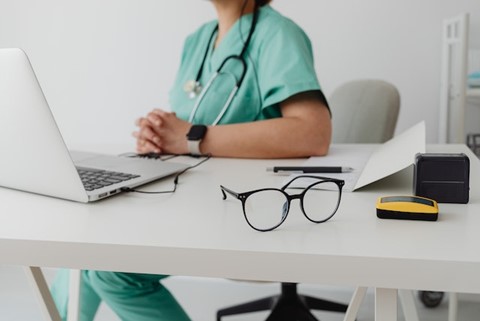Are you tired of breaking a sweat just thinking about the cleanliness of your gym?…
Best Practices for Maintaining a Clean and Safe Workplace for Healthcare Facilities
 Maintaining a clean and safe workplace is paramount in the fast-paced world of healthcare. Whether it’s a bustled medical office, a busy dental practice, or a cutting-edge outpatient surgery center, upholding stringent cleanliness and safety standards cannot be overstated.
Maintaining a clean and safe workplace is paramount in the fast-paced world of healthcare. Whether it’s a bustled medical office, a busy dental practice, or a cutting-edge outpatient surgery center, upholding stringent cleanliness and safety standards cannot be overstated.
With the well-being of patients, staff, and visitors at stake, it is crucial to implement effective practices that foster a pristine environment free from hazards and potential infections. Therefore, this blog post we will explore the best practices that healthcare facilities, such as physician groups, rehab centers, and labs, can employ to ensure a consistently hygienic and protected workspace. By adhering to these guidelines, medical professionals can focus on delivering exceptional care while promoting a healthy and secure environment for all.
The Significance of Maintaining a Clean and Safe Workplace
A spotless and secure work area not only safeguards the health and well-being of employees but also plays a crucial role in promoting patient confidence and satisfaction. When patients enter a medical office, dental practice, or healthcare facility, they expect a clean and sanitary environment.
Thus, by prioritizing cleanliness, healthcare providers demonstrate their commitment to maintaining high standards of care. Moreover, a clean and safe workplace reduces the risk of healthcare-associated infections, thus preventing the spread of diseases and protecting both patients and staff.
Creating and Implementing a Comprehensive Cleaning Routine
You must establish a comprehensive cleaning routine to maintain a tidy and hazard-free environment. Regularly disinfecting:
- surfaces
- equipment
- waiting areas
- and restrooms
is vital to eliminate harmful bacteria, viruses, and other pathogens.
Assigning specific cleaning tasks to designated personnel ensures accountability and consistency in maintaining cleanliness throughout the facility. Additionally, using appropriate cleaning agents and following the manufacturer’s instructions for disinfection guarantees optimal effectiveness. Regular training sessions for cleaning staff can reinforce proper techniques and ensure they stay updated on the latest industry practices.
Ensuring Adequate Waste Management
Proper waste management is integral to maintaining a sanitary and secure workplace in healthcare facilities. Waste generated in medical offices, dental office, and labs can contain hazardous materials and potentially infectious substances.
Therefore, it is crucial to establish clear guidelines for waste segregation, disposal, and recycling. Providing designated waste disposal containers and ensuring proper labeling reduces the risk of cross-contamination. It enhances safety. Regularly scheduled waste pick-ups and adhering to local regulations for medical waste disposal is vital to maintaining a hygienic environment.
Promoting Hand Hygiene Practices
Hand hygiene is fundamental to maintaining a clean and safe workplace in healthcare settings. Healthcare professionals must follow proper handwashing protocols before and after patient interactions, after handling contaminated materials, and before putting on gloves.
Therefore, you should place accessible hand hygiene stations with soap, water, and hand sanitizers strategically throughout the facility. Regular education and reminder about hand hygiene techniques, including using hand sanitizers with at least 60% alcohol content, promote adherence to best practices among staff members, reducing the risk of infection.
Implementing Effective Infection Control Measures
Infection control is crucial in healthcare environments to prevent the spread of pathogens and protect the health of patients and staff. Implementing effective infection control measures involve a combination of strategies, including:
- proper sterilization and disinfection of medical instruments
- maintaining clean and well-ventilated patient care areas
- and practicing appropriate respiratory hygiene and cough etiquette
Adherence to standard precautions, such as using personal protective equipment (PPE) and safe injection practices, further enhances infection control efforts. Regular training sessions and audits can help identify areas for improvement and reinforce compliance with infection control protocols.
Ensuring Smooth Transitions and Continuity
In addition to the core practice of maintaining an organized and healthy workplace, healthcare facilities sometimes need to handle the packing process as they prepare for changes such as a move or renovation. Addressing these logistics ensures uninterrupted operations and consistently delivers high-quality care.
Healthcare facilities should consider how the process many impact cleanliness and safety measures when planning a relocation or renovation. Properly organizing and packing equipment, medical supplies, and documents can facilitate a seamless transition while minimizing any disruptions to cleanliness protocols.
Educating Staff on Cleanliness and Safety Protocols
Education and training are vital in maintaining a hygienic and protected workplace. It is essential to provide comprehensive training programs for all staff members, including medical professionals, administrative personnel, and support staff.

These programs should cover proper cleaning and disinfection techniques, waste management protocols, hand hygiene practices, and infection control measures. By ensuring that all employees are well-informed and trained, healthcare facilities can establish a culture of cleanliness and safety, where everyone understands their role and responsibilities in maintaining a pristine environment.
Encouraging a Culture of Accountability
Creating a culture of accountability involves fostering a sense of responsibility among employees to adhere to cleanliness and safety protocols.
Encourage staff members to promptly report any potential hazards, spills, or maintenance issues. Regular inspections and audits can help identify areas requiring attention or improvement. Recognize and reward employees who consistently uphold cleanliness and safety standards, reinforcing the importance of their contributions to promoting a healthy and secure environment for all.
Enhancing Communication and Collaboration
Effective communication and collaboration are essential for maintaining a sanitary and secure workplace. Establish clear channels of communication between different departments and staff members to address cleanliness-related concerns promptly.
You can hold regular meetings or huddles to discuss challenges, share best practices, and update everyone on cleanliness and safety protocols. Encourage open dialogue and feedback to identify areas for improvement and implement necessary changes. By fostering a collaborative environment, healthcare facilities can proactively address cleanliness issues and ensure a safer workplace for everyone involved.
Keeping Up with Evolving Guidelines and Regulations
The healthcare industry is constantly evolving, and guidelines and regulations related to cleanliness and safety are regularly updated. Healthcare facilities must stay informed and adapt their practices accordingly.
Stay updated with recommendations from reputable sources such as the Centers for Disease Control and Prevention (CDC), and regulatory bodies specific to your region. Review and revise cleaning protocols and safety measures to align with the latest guidelines. By staying proactive and informed, healthcare facilities can maintain the highest cleanliness and safety standards.
Conclusion
Discover essential best practices for maintaining clean and safe workplace, including regular cleaning routines, proper waste management, hand hygiene promotion, infection control measures, staff education, accountability, effective communication, and adherence to guidelines, ensuring optimal conditions for exceptional care and instilling confidence among patients and staff.

